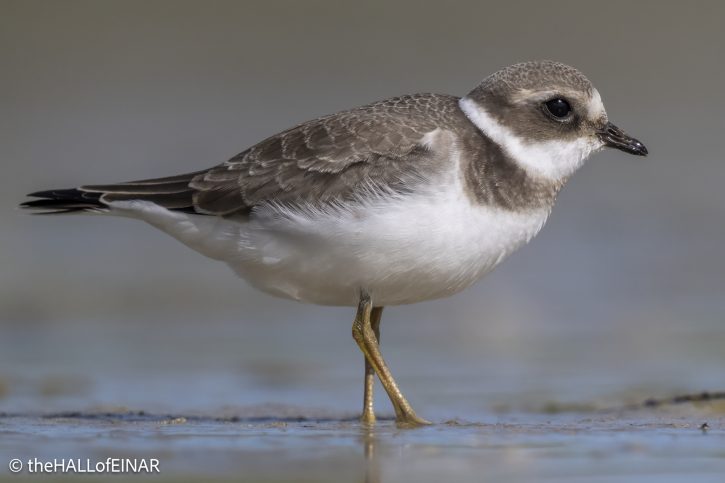Ringed Plover
Now that I can identify a few species of waders my next task is to understand whether they are adults or juveniles. I’d even like to know whether they are 2cy (second calendar year) or 1st summer types or maybe they’re adults in winter or summer plumage. It’s not that easy.
Here’s a Common Ringed Plover, Charadrius hiaticula, in beautiful light at The Ouse:

My current favourite book (or books – it’s a two-volume set) is the ID Handbook of European Birds by Nils van Duivendijk. It has a couple of pages of plumage variations of the Common Ringed Plover. I can tell straight away that this is not a summer-type plumage adult bird. Adults have beautiful yellow eye-rings, orange and black striped beaks and dark striped head and breast plumage in summer. Just look at how gorgeous this one looks:

I study the pages intently. Both of the Adult winter (September) and the Juvenile (October) photographs look identical to me and both look identical to my first photograph above.
The description for Adult winter says the wing covert feathers are “uniform” but the Juvenile has a “dark subterminal fringe and pale tip” on the wing coverts. Maybe that scalloped effect on the wings means it’s a juvenile. Or maybe they’re just very worn? But is that likely at this time of year when they would have just had a new set of feathers after breeding?
I’m going with it being a juvenile.
Being wrong is a part of learning and there’s no shame in it. There’s also no triumph in correcting people who are still learning, which, to be honest, should be all of us.
More Ringed Plovers
 Ringed Plover on the road The Ringed Plovers have an entire beach to strut on but they will insist on cruising down the road. But… read more
Ringed Plover on the road The Ringed Plovers have an entire beach to strut on but they will insist on cruising down the road. But… read more A fluffy bundle of feathers I'm driving to the Arctic Tern colony to take some photographs of them bringing fish in to their chicks when… read more
A fluffy bundle of feathers I'm driving to the Arctic Tern colony to take some photographs of them bringing fish in to their chicks when… read more Ringed Plover chick There's a Ringed Plover chick on the rocky beach. Charming, aren't they? I've been here before to photograph them. Last… read more
Ringed Plover chick There's a Ringed Plover chick on the rocky beach. Charming, aren't they? I've been here before to photograph them. Last… read more A scuttling Sandy Laverock The Orkney name for Ringed Plover is Sandy Laverock. It's a beautiful name for a beautiful bird. They appear to… read more
A scuttling Sandy Laverock The Orkney name for Ringed Plover is Sandy Laverock. It's a beautiful name for a beautiful bird. They appear to… read more How low can you go? I'd like you to have a look at two of my photographs, taken a minute or two apart. They are… read more
How low can you go? I'd like you to have a look at two of my photographs, taken a minute or two apart. They are… read more Ground-nesting Sandy Laverock There's a Ringed Plover nest here, next to the footpath, near the coast: I can tell that because, as I… read more
Ground-nesting Sandy Laverock There's a Ringed Plover nest here, next to the footpath, near the coast: I can tell that because, as I… read more Sandy Laverock This juvenile Ringed Plover is a wonderful bird. In Orkney the Ringed Plover is called Sandy Laverock. The UK conservation… read more
Sandy Laverock This juvenile Ringed Plover is a wonderful bird. In Orkney the Ringed Plover is called Sandy Laverock. The UK conservation… read more Ringed Plover Ringed Plover are meant to breed on the coast. Human destruction of the environment means they now breed in gravel… read more
Ringed Plover Ringed Plover are meant to breed on the coast. Human destruction of the environment means they now breed in gravel… read more Don’t try that old broken wing trick on me, Sandy Laverock We're walking around the north coast of Papa Westray. It's one of the smaller inhabited islands of the Orkney archipelago.… read more
Don’t try that old broken wing trick on me, Sandy Laverock We're walking around the north coast of Papa Westray. It's one of the smaller inhabited islands of the Orkney archipelago.… read more